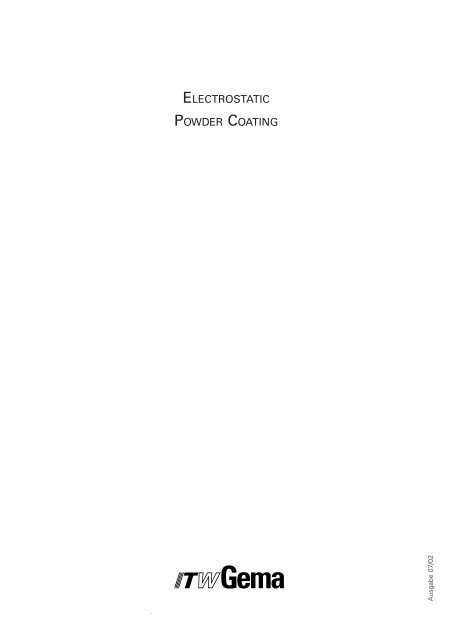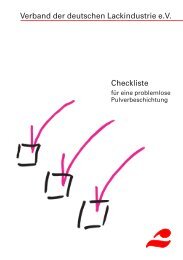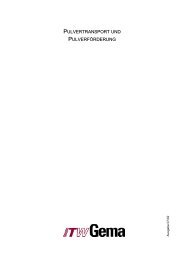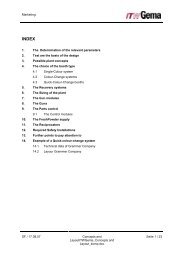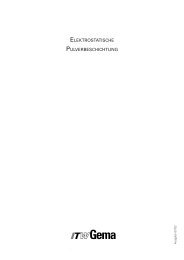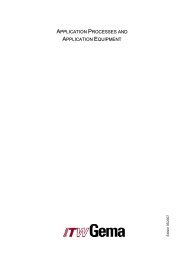ELECTROSTATIC POWDER COATING
ELECTROSTATIC POWDER COATING
ELECTROSTATIC POWDER COATING
Create successful ePaper yourself
Turn your PDF publications into a flip-book with our unique Google optimized e-Paper software.
Marketing<br />
Electrostatic Powder Coating<br />
<strong>ELECTROSTATIC</strong><br />
<strong>POWDER</strong> <strong>COATING</strong><br />
13<br />
Ausgabe 07/02
Ausgabe 02/03<br />
Marketing<br />
14 Electrostatic Powder Coating
Marketing<br />
Electrostatic Powder Coating<br />
Table of Contents<br />
1 Introduction ................................................................ 1<br />
2 The basic principle ..................................................... 1<br />
3 The Powder ................................................................. 2<br />
3.1 The manufacturing .......................................................2<br />
3.2 The powder types ........................................................2<br />
3.2.1 Epoxy resin powder ............................................2<br />
3.2.2 Epoxy/polyester powder (hybrids).......................3<br />
3.2.3 Polyester/TGIC ....................................................3<br />
3.2.4 Polyester/hydroxy alkylamide ..............................3<br />
3.2.5 Polyurethane .......................................................3<br />
3.2.6 Acrylic powder ...................................................3<br />
3.2.7 Enamel powder ...................................................4<br />
4 The plant concept ...................................................... 4<br />
4.1 The plant design ...........................................................4<br />
4.2 The conveyor system ...................................................4<br />
4.3 The hanger design .......................................................5<br />
5 Pretreatment............................................................... 5<br />
5.1 Cleaning of the parts for plastic coating.......................5<br />
5.2 Dry-off oven .................................................................6<br />
5.3 Cleaning of the parts for enamel coating .....................6<br />
6 The charging of the powder ...................................... 7<br />
6.1 Electrostatic charging ...................................................7<br />
6.2 Frictional charging ........................................................7<br />
7 The powder circuit ..................................................... 7<br />
8 Criteria for the choice of the appropriate plant .........<br />
concept........................................................................ 8<br />
9 Powder coating appliances ....................................... 9<br />
9.1 Manual coating appliances ...........................................9<br />
9.2 Automatic appliances ...................................................9<br />
9.3 The powder booth ........................................................9<br />
9.4 Injectors ..................................................................... 10<br />
9.5 Reciprocators ............................................................. 10<br />
9.6 Fresh powder systems .............................................. 10<br />
9.7 Separation filters and cyclones .................................. 10<br />
10 Curing ovens ............................................................. 11<br />
11 Energy-saving measures .......................................... 11<br />
12 Conclusions .............................................................. 11<br />
15<br />
Ausgabe 07/02
Ausgabe 02/03<br />
Marketing<br />
16 Electrostatic Powder Coating
Marketing<br />
1 Introduction<br />
2 The basic principle<br />
Electrostatic Powder Coating<br />
Electrostatic powder coating is one of the most environmentally<br />
friendly and economical technologies in surface treatment. Since the<br />
early 60’s, powder-coating paints have been available on the market<br />
and their problem-free production and processing made powder coating<br />
a well-established and commonly recognized technique. In fact, powder<br />
coatings are<br />
- environmentally friendly<br />
- energy-saving<br />
- safe to handle and process<br />
- highly economical.<br />
New developments focus on thin-film powders, powders for specific<br />
applications and radiation curing systems.<br />
Electrostatic powder coating is based on the fact that particles with<br />
opposite charges attract each other. This is why most of the conductive<br />
and thermally stable solids are suitable for powder coating. Today,<br />
electrostatic powder coating considerably increases its presence in the<br />
domain of metallic objects such as:<br />
- aluminum profiles<br />
- façade elements<br />
- household appliances<br />
- automotive accessories (e.g. rims, roof racks)<br />
- office furniture<br />
- storage equipment<br />
- outdoor furniture<br />
- wire products etc.<br />
Hence, everybody comes into contact with this technology every day.<br />
The powder coating process:<br />
Dry coating powder is filled in a hopper, fluidized or stirred and<br />
subsequently transported by means of compressed air via injectors to<br />
the powder gun. In this gun, high voltage is created from a low voltage<br />
of 10V utilizing the cascade principle. During the spraying process, one<br />
or more electrodes charge the powder with 60 - 100 kV.<br />
An electrical field is generated between the gun and the grounded<br />
1<br />
Ausgabe 07/02
Ausgabe 02/03<br />
3 The Powder<br />
3.1 The manufacturing<br />
3.2 The powder types<br />
3.2.1 Epoxy resin powder<br />
Marketing<br />
workpiece. The powder particles follow the field lines and, due to the<br />
residual charge, remain bonded to the object (3). Once coated, the<br />
workpieces are either manually or automatically transferred to a curing<br />
oven. Plastic powders are cured at temperatures between 140ºC and<br />
200ºC, fusing into a smooth coating with layer thicknesses of 30 - 80µ<br />
for decorative and 200 - 500µ for functional purposes.<br />
Enamel powders may be applied in a layer thickness range of 80 - 200µ,<br />
requiring sensitively higher curing temperatures varying from 780°C to<br />
830ºC due to their specific chemical properties.<br />
Powder coatings typically contain:<br />
- binders (resins, hardeners, accelerators)<br />
- pigments and colorants<br />
- fillers (extenders)<br />
- additives<br />
Binders and hardeners are solid resins and also additives are solids. All<br />
ingredients of the formulation are weighed out and pre-mixed in a<br />
special machine. In the subsequent extruding process, the blend is<br />
melt at 100°C - 120°C and dispersed, resulting in a homogenous melt.<br />
After being conveyed over cooling rollers and a cooling belt for final<br />
cooling, the material is broken into small flakes, ground and finally<br />
packaged. At this stage, the product is ready for use and will be applied<br />
in its dry state by the customer, the end-user of the powder.<br />
Epoxy resin powders exhibit good chemical resistance to solvents,<br />
acids and alkaline liquids.<br />
A predominant disadvantage of epoxy resin powders is their chalking<br />
and yellowing tendency when exposed to UV light. Chalking does mean<br />
loss in aesthetics, but not in anti-corrosive benefits.<br />
Today, epoxy powder coatings nearly exclusively serve in the functional<br />
domain, e.g. in the electrical and electronic industry, for automotive<br />
parts, fittings, reinforced iron, pipe coatings, etc.<br />
2 Electrostatic Powder Coating
Marketing<br />
3.2.2 Epoxy/polyester powder (hybrids)<br />
3.2.3 Polyester/TGIC<br />
3.2.4 Polyester/hydroxy alkylamide<br />
3.2.5 Polyurethane<br />
3.2.6 Acrylic powder<br />
Electrostatic Powder Coating<br />
Epoxy/polyester powders, as the name already says, are a blend of<br />
epoxy and polyester resins. Featuring better resistance to yellowing<br />
and a reduced chalking tendency compared to pure epoxies, these<br />
powders are preferably used for decorative purposes. Further<br />
application fields for hybrids are ceiling elements, lights, metal furniture,<br />
shop fittings and shelving etc.<br />
A disadvantage is the poorer resistance to solvents in comparison with<br />
pure epoxy resin powders.<br />
Polyester resin powders are used when superior non-chalking and<br />
weather-resistant properties are required. Their advantageous<br />
mechanical characteristics as impact resistance and good adhesion<br />
allow ulterior processing as sawing, drilling or milling. Polyester resins<br />
are typically applied to aluminum or steel for outdoor purposes, in<br />
particular in the automotive sector, for façade elements, window<br />
profiles or high-quality garden and camping furniture. This type of<br />
powder is making increasing inroads into the interior decoration market<br />
where superior yellowing and chalking resistance is favored.<br />
As TGIC is classified a toxic substance, mandatory labeling applies to<br />
powder coatings with a TGIC proportion of 0.1%.<br />
As an alternative to the above mentioned polyester/TGIC powders, this<br />
type of coating was introduced into the market in 1990. Polyester/<br />
hydroxy alkylamide powders exhibit excellent weather-resistant and<br />
non-chalking characteristics, representing a valid alternative to<br />
polyester and polyurethane powder coatings for all outdoor<br />
applications.<br />
The application fields of this powder category are identical with those<br />
of polyester/TGIC powder coatings, though curing temperatures for<br />
PUR powder coatings are generally higher and some compounds may<br />
have a lower performance in regards to edge coverage. However, it<br />
exhibits noteworthy flow and coating characteristics.<br />
The weather-resistant acrylic powder coatings are based on acrylic<br />
resins and typically contain dicarboxylic acids, isocyanates or<br />
anhydrides of dicarboxylic acids. This type of powder coating combines<br />
outstanding characteristics:<br />
- flow characteristics comparable to standard liquid coatings in the<br />
automotive industry<br />
- excellent weather stability (5 years Florida)<br />
- high gloss level<br />
- emission-free and low waste generation<br />
3<br />
Ausgabe 07/02
Ausgabe 02/03<br />
3.2.7 Enamel powder<br />
4 The plant concept<br />
4.1 The plant design<br />
4.2 The conveyor system<br />
Marketing<br />
However, the drawbacks of acrylic powders include special storage<br />
requirements and incompatibility with other powder coatings. Their<br />
positive characteristics predestine them for application purposes in the<br />
automotive industry.<br />
Enamels are glass-like substances that are obtained by the melting of<br />
oxygen-containing components. With metallic base materials such as<br />
steel, cast iron or aluminum, these powders form composite materials<br />
that withstand temperatures up to 450°C and feature color stability and<br />
scratchproof characteristics. Surfaces refined with this type of coating<br />
exhibit excellent mechanical and chemical properties.<br />
Further reading:<br />
The above listing is not exhaustive and gives only a rough overview on<br />
powder coatings. We recommend the following specialized literature<br />
for further information:<br />
Judith Pietschman. Title: Industrielle Pulverbeschichtung.<br />
Friedr. Vieweg & Sohn Verlagsgesellschaft mbH, Braunschweig,<br />
www.vieweg.de<br />
ISBN 3-528-03380-0<br />
An industrial powder coating plant for automated coating typically<br />
includes the following: pretreatment, dry-off oven, coating area, curing<br />
oven and conveyor system. Please refer to the following schematic<br />
plant layout as an example. Depending on the specific needs, especially<br />
in the field of enamel powder coating, various conveyor circuits and dryoff<br />
ovens may be needed. For minor production quantities or special<br />
colors, a small booth for manual coating may be sufficient in most<br />
cases. This booth needs a minimum of space and fits in every<br />
production facility.<br />
Conveyor systems for the transportation of workpieces serve to the<br />
automation of the coating process. Primarily, these systems are<br />
subdivided into two categories: overhead and belt conveyors. Many<br />
transportation problems, in particular if light or extremely heavy<br />
workpieces have to be maneuvered, may be resolved with a single<br />
strand or a circular conveyor. If long, big or bulky workpieces are to be<br />
coated or available space is restricted, the power-and-free conveyor is<br />
an ideal solution, as it allows alternatively parallel or diagonal travel.<br />
Due to its sophisticated design, it is more expensive but offers a more<br />
4 Electrostatic Powder Coating
Marketing<br />
4.3 The hanger design<br />
5 Pretreatment<br />
Electrostatic Powder Coating<br />
flexible adaptation to continuous and automated coating, in particular<br />
as load and unload zone of the workpieces and the coating processes<br />
can work in their individual rhythm. Further advantages over other<br />
conveyor systems are the modular design for optimized material flow<br />
and easy combination with elevator/lowerator stations. Particular<br />
attention should be paid to the lubrication of the conveyor system, as<br />
dry-off ovens with temperatures up to 250°C require high-temperature<br />
resistant lubricants or alternatively ventilated protective channels for<br />
the chains.<br />
Efficient conveyor technology requires a production-oriented hanger<br />
design. How the hanger design should look like depends on the specific<br />
application. Sufficient stability guarantees trouble-free coating and<br />
assures a smooth production process. Most of the time, the hangers<br />
are partly coated in the coating process; this is why round materials<br />
should be preferred. Efficient production requires two complete hanger<br />
sets: when one hanger set gets too dirty, the replacement set is used<br />
while removing the coating from the other.<br />
5.1 Cleaning of the parts for plastic coating<br />
Before coating the workpieces, all impurities such as grease, oil, dirt<br />
etc. must be cleaned off. This cleaning process takes place in the multizone<br />
pretreatment system. According to the material, the subsequent<br />
step is pickling, phosphating or chromatizing. In general, steel sheets<br />
are phosphated, galvanized steel sheets slightly pickled for improved<br />
adhesion and aluminum sheets chromatized. By means of the conveyor<br />
system, the workpieces are guided through the different treatment<br />
sections where chemicals as slightly acid alkaline phosphates, alkaline<br />
bases or acids are used. In the spraying tunnel, which is equipped with<br />
a nozzle system, the workpieces are sprayed from all angles. As<br />
coating results substantially depend on perfect cleaning and a precisely<br />
adapted pretreatment, the quantity of nozzles, spraying angle and pump<br />
power have to be adapted to the respective workpieces.<br />
Also metal cleaning systems, which are manufactured in modular units,<br />
have to be custom-designed solutions accurately adapted to the<br />
specific case. Overdimensioning means waste of energy and raw<br />
materials. As a matter of principle, measures for efficient<br />
environmental care and raw material recycling are to be taken into<br />
account in all pretreatment concepts. Dimensions and layout of the<br />
cleaning zones may be individually designed according to the<br />
workpieces and specific needs of the customer. In the conception of<br />
pretreatment systems, economical consumption of water, raw<br />
materials and particularly thermal energy should be top priority.<br />
5<br />
Ausgabe 07/02
Ausgabe 02/03<br />
5.2 Dry-off oven<br />
Marketing<br />
After passing all pretreatment zones by means of the conveyor system,<br />
residual humidity is eliminated in the dry-off oven. The latter is<br />
comparable to a curing oven but designed in a simpler way, reaching<br />
temperatures up to 150°C. Depending on the type of workpiece,<br />
blowing off with normal room air by means of nozzles may be<br />
sufficient.<br />
5.3 Cleaning of the parts for enamel coating<br />
Basic prerequisite for the successful application of enamel powder<br />
coatings are flawlessly pretreated steel workpieces. In order to meet<br />
the required quality standards for this specific application, pretreatment<br />
lines including up to 20 steps may be necessary. However, this<br />
maximum is only required if steel is extremely dirty or rusty. In general,<br />
only good quality stainless steel suited for enameling is processed. In<br />
this case, the pretreatment zone may be reduced to the following 6<br />
steps:<br />
Bath 1 Degreasing<br />
Bath 2 Degreasing<br />
Bath 3 Degreasing<br />
Bath 4 Rinsing<br />
Bath 5 Rinsing<br />
Bath 6 Static rinsing<br />
For extremely dirty parts, the following steps are required:<br />
Bath 1 Degreasing<br />
Bath 2 Degreasing<br />
Bath 3 Degreasing<br />
Bath 4 Rinsing<br />
Bath 5 Rinsing<br />
Bath 6 Pickling (rust removal)<br />
Bath 7 Rinsing<br />
Bath 8 Rinsing<br />
Bath 9 Degreasing<br />
Bath 10 Rinsing<br />
Bath 11 Rinsing<br />
Bath 12 Pickling<br />
Bath 13 Rinsing<br />
Bath 14 Nickel-plating<br />
Bath 15 Rinsing<br />
Bath 16 Complexating<br />
Bath 17 Rinsing<br />
Bath 18 Static rinsing / Passivating<br />
The above-mentioned procedures clearly illustrate that cost savings in<br />
pretreatment depend on the right choice of coating goods. Only highquality<br />
and absolutely rust-free steel allows a pretreatment phase in 6<br />
steps.<br />
6 Electrostatic Powder Coating
Marketing<br />
6 The charging of the powder<br />
6.1 Electrostatic charging<br />
6.2 Frictional charging<br />
7 The powder circuit<br />
Electrostatic Powder Coating<br />
Various systems are used to charge the powder. The choice of the<br />
process depends on the application and the desires of the user. Generally,<br />
three different charging processes are distinguished: electrostatic<br />
charging, charging with low ionization and tribo charging. Virtually all<br />
manufacturers attain the reduction of air-ionization by the use of a<br />
special centerpiece on the top of the gun (called SuperCorona at ITW<br />
Gema).<br />
The corona discharging is the unrestrained escape of free electrons<br />
from an electrical conductor. The electrostatic gun is equipped at its top<br />
with an electrode that expels electrons. When exiting the powder gun,<br />
the powder particles are charged through the deposition of air ions. The<br />
resulting ionized powder particles, similar to the free ionized air<br />
particles, are attracted to all earthed objects. In practice, the earthed<br />
object is the workpiece, thus the powder remains bonded to it.<br />
The charging principle with constant feed of electrostatic charge allows<br />
the use of this gun type in all application cases and for virtually all<br />
powder categories available on the market.<br />
In this process, also called tribo charging, powder particles are charged<br />
by means of friction with other plastic materials. This process can take<br />
place in a pipe, tube or over a plate. Ideally, it should take place at high<br />
air velocity, as the resulting turbulences in the pipe will increase the<br />
number of contacts. The used plastic material is generally teflon with<br />
positive load.<br />
For detailed information on powder charging, please refer to the<br />
following notes: „Process of Application and Application Appliances“ by<br />
ITW Gema AG.<br />
In a powder coating system, the powder has to be forwarded from one<br />
place to another, taking into consideration the specific characteristics<br />
and safety rules. The most common application is the transportation of<br />
the powder from the original container or the powder container directly<br />
to the gun. In automatic systems, the powder is transported from the<br />
fresh powder container into an intermediate container (e.g. in a powder<br />
center) and from there on to the gun. The overspray powder is<br />
collected in the booth, recovered and fed back to the intermediate<br />
container. The properties of the powder should not be altered by the<br />
transportation. Consequently, the powder transportation should be<br />
such as to preserve the original powder properties.<br />
For detailed information on powder conveying, please refer to the<br />
following notes: „Powder Transportation and Powder Conveying“ by<br />
ITW Gema AG.<br />
7<br />
Ausgabe 07/02
Ausgabe 02/03<br />
8 Criteria for the choice of the appropriate plant concept<br />
Marketing<br />
The planning of a powder coating plant often originates with the desire<br />
or the obligation for an environmentally friendly coating process or<br />
extensive automation of the coating process. Many relevant<br />
parameters determining the choice between various plant concepts and<br />
system, cabin and recycling types arise out of the objects to be coated<br />
and the plant technique to be chosen. Also the grade of automation to<br />
be selected is already determined in this phase.<br />
Parameters determined by the objects:<br />
First of all, essential parameters, which influence the design of the<br />
plant, should be determined:<br />
- quantity of the parts to be coated<br />
- workpiece geometry<br />
- type of powder<br />
- requested layer thicknesses<br />
- requested coating quality<br />
- number of shades<br />
- proportional distribution of main colors and special shades<br />
- frequency of color changes<br />
Parameters determined by the plant technique and structural<br />
conditions:<br />
Further parameters, which influence the choice of the coating booth,<br />
are the following:<br />
- chain conveyor<br />
- hanger design<br />
- pretreatment<br />
- space available<br />
- floor quality and other interfering influences (e.g. air currents)<br />
For detailed information on powder coating plants, please refer to the<br />
following notes: „Powder Coating Plants – Concepts and Design“ by<br />
ITW Gema AG.<br />
8 Electrostatic Powder Coating
Marketing<br />
9 Powder coating appliances<br />
9.1 Manual coating appliances<br />
9.2 Automatic appliances<br />
9.3 The powder booth<br />
Electrostatic Powder Coating<br />
Application appliances fall into two categories: manual coating<br />
appliances and automatic appliances. Standardized modules are<br />
combined according to the specific needs of the customer. Application<br />
appliances always comprise a control, a gun and a powder container. In<br />
general, one control module individually controls one powder gun.<br />
However, PC and SPS controls are increasingly used in automatic<br />
plants. With regards to the powder containers, fluidic systems, vibrated<br />
containers or stirrers may be chosen. Also the original powder<br />
container of the powder manufacturer may be used, for example in<br />
powder centers, which is particularly indicated when frequent and quick<br />
color changes are requested.<br />
In general, manual coating systems consist in a control, a manual gun,<br />
a powder container, a precision injector for powder transportation,<br />
cables and pneumatic ducts. Powerful manual coating systems are<br />
particularly indicated for small and mid series productions. As generally<br />
frequent color changes are needed, they should always be easy to<br />
clean.<br />
The automatic system consists generally in the same elements as a<br />
manual appliance. However, in automatic appliances mainly automatic<br />
guns are to be found. Additionally, locking and automatic control units<br />
are used. High power appliances for the automatic coating have to<br />
meet the requirements for large batch productions. Individual modular<br />
systems for custom-designed solutions with standard elements ideally<br />
suit these demands.<br />
Powder booths are typically subdivided into different categories, each<br />
of them suiting specific needs: single color application, multi color<br />
application, quick color changes.<br />
Booths are made of steel or, for quick color change systems, sandwich<br />
constructions in plastic are available.<br />
Plastic booths are more expensive than steel booths but offer reduced<br />
cleaning times as excess powder hardly sticks to the walls.<br />
Sophisticated installations with round booths and central aspiration<br />
located underneath the guns help to keep the powder quantity in the<br />
powder circuit at a low level.<br />
Conventional metallic booths are used for single color systems, e.g. for<br />
white goods and enamel coating. These are equipped with a direct filter<br />
recovery system and in some cases with a blade system, which<br />
collects excess powder on the floor.<br />
9<br />
Ausgabe 07/02
Ausgabe 02/03<br />
9.4 Injectors<br />
9.5 Reciprocators<br />
9.6 Fresh powder systems<br />
9.7 Separation filters and cyclones<br />
Marketing<br />
The injector transports a pre-defined quantity of powder from the<br />
powder containers to the guns. Similar injectors, which are made of<br />
abrasive resistant material, are used for enamel powders.<br />
Reciprocators move the spray guns evenly in a vertical direction.<br />
Depending on the application, different types of reciprocators may be<br />
selected where guns are aligned vertically or horizontally. For complex<br />
part shapes, a multi-axial design version allows the entire reciprocator<br />
to follow over a certain distance or single guns to be moved separately.<br />
These systems are used in applications with high powder consumption<br />
or if quality requirements demand constant entrainment of fresh<br />
powder to the recovered powder.<br />
Quick color changing systems always require the use of monocyclones.<br />
These separate the retrieved powder from the suction air.<br />
The separation level of a mono-cyclone amounts to approximately 95%<br />
and depends on the specific characteristics of the used powder type.<br />
As to single color systems, separation filters are directly flanged to the<br />
booth. The powder separation takes place by means of plate filters with<br />
high separation levels or space-saving cartridge filters.<br />
For detailed information on particular appliances for the powder coating<br />
process, please refer to the following notes:<br />
„Powder Transportation and Powder Conveying“, „Process of<br />
Application and Application Appliances“ and „Powder Coating Plants –<br />
Concepts and Design“ by AG<br />
10 Electrostatic Powder Coating
Marketing<br />
10 Curing ovens<br />
11 Energy-saving measures<br />
12 Conclusions<br />
Electrostatic Powder Coating<br />
Subsequent to the powder application, the workpieces may be transferred<br />
directly into the curing oven. In the end, it is the temperature<br />
accuracy of the latter and further factors that determine the finish.<br />
The re-circulating air quantity depends on the required temperature, the<br />
heat consumption and the difference between intake and exhaust air<br />
temperatures. The temperature tolerance range amounts to +/- 5°C.<br />
The dimensions of the interior parts of the oven such as partitions,<br />
reinforcements or thermal insulations substantially influence the<br />
duration of warm-up and holding times. Further essential criteria for the<br />
oven design are the type of the workpiece, its hanger density and<br />
material thickness.<br />
The choice between a continuous oven, a U-turn furnace or one of the<br />
numerous design alternatives is determined by the concept the whole<br />
installation and space availability. The experienced plant manufacturer<br />
will be flexible and adapt his concept to make the most suitable choice<br />
in line with the specific customer needs.<br />
A further factor determining the surface quality is the dwell time in the<br />
oven. For a continuous oven, this means that a planned workpiece<br />
throughput has to be held for a given amount of time at the required<br />
temperature that may not exceed the acceptable tolerance rate.<br />
Depending on the type of powder, the curing temperature may go up to<br />
250°C.<br />
As thermal energy is costly, savings in this field are always an issue of<br />
current interest. The responsible-minded constructor will integrate this<br />
problem in his concept and know adequate measures to keep energy<br />
consumption as low as possible. The plant manufacturer supports you<br />
in your decision with regards to thermal isolation, heat recycling<br />
systems, the right choice between direct and indirect heating, etc<br />
During the last few years, the environmentally friendly powder coating<br />
technology has gained increasing importance and is still achieving high<br />
growth rates. Compact, modern plant design and the development of<br />
fully automated coating processes keep cost factors such as space and<br />
personnel at a low level.<br />
No use of solvents, the possibility to retrieve and reuse the powder,<br />
efficiency rates that can exceed 99% and short color changing times<br />
combined with high-precision control technology make powder coating<br />
the most economical technique in surface treatment.<br />
11<br />
Ausgabe 07/02
Ausgabe 02/03<br />
Marketing<br />
12 Electrostatic Powder Coating


